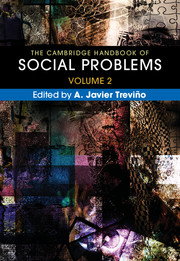Book contents
- The Cambridge Handbook of Social Problems
- The Cambridge Handbook of Social Problems
- Copyright page
- Contents
- About the Contributors
- Introduction
- Part I Problems Related to Health, Safety, and Security
- Chapter 1 Illness and Health Care
- Chapter 2 Mental Illness and Social Problems
- Chapter 3 Substance Abuse
- Chapter 4 Epidemics, Pandemics, and Outbreaks
- Chapter 5 Disaster as Social Problem and Social Construct
- Chapter 6 Surveillance
- Chapter 7 Domestic Spying: A Historical-Comparative Perspective
- Chapter 8 Computer Hacking as a Social Problem
- Chapter 9 War and Militarism
- Chapter 10 The Social Problem of Terrorism
- Chapter 11 Genocide
- Part II Problems Related to Crime and Violence
- Part III Problems of Global Impact
- Index
- References
Chapter 2 - Mental Illness and Social Problems
from Part I - Problems Related to Health, Safety, and Security
Published online by Cambridge University Press: 16 March 2018
- The Cambridge Handbook of Social Problems
- The Cambridge Handbook of Social Problems
- Copyright page
- Contents
- About the Contributors
- Introduction
- Part I Problems Related to Health, Safety, and Security
- Chapter 1 Illness and Health Care
- Chapter 2 Mental Illness and Social Problems
- Chapter 3 Substance Abuse
- Chapter 4 Epidemics, Pandemics, and Outbreaks
- Chapter 5 Disaster as Social Problem and Social Construct
- Chapter 6 Surveillance
- Chapter 7 Domestic Spying: A Historical-Comparative Perspective
- Chapter 8 Computer Hacking as a Social Problem
- Chapter 9 War and Militarism
- Chapter 10 The Social Problem of Terrorism
- Chapter 11 Genocide
- Part II Problems Related to Crime and Violence
- Part III Problems of Global Impact
- Index
- References
Summary
Mental illness is not only in itself considered a major social problem, it also often results from the diverse social problems individuals have to face. This chapter explores four questions relevant to the extent of mental illness as a social problem and to the way in which social problems generate mental ill health. How is mental illness defined? What do the data show about its extent? What is the evidence that mental illness is often the result of social problems in individuals’ lives? And finally, how should mental illness be dealt with?
- Type
- Chapter
- Information
- The Cambridge Handbook of Social Problems , pp. 23 - 42Publisher: Cambridge University PressPrint publication year: 2018



